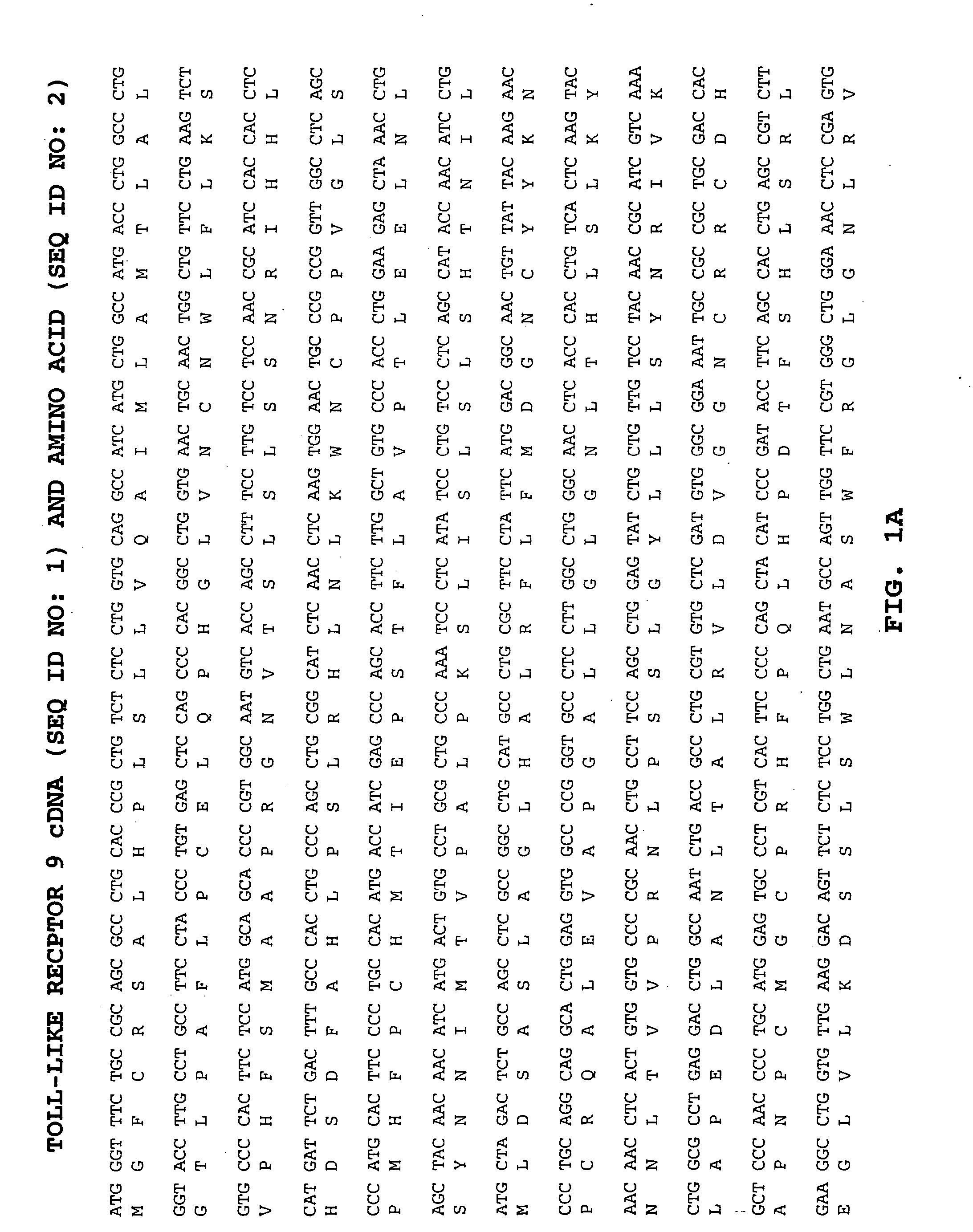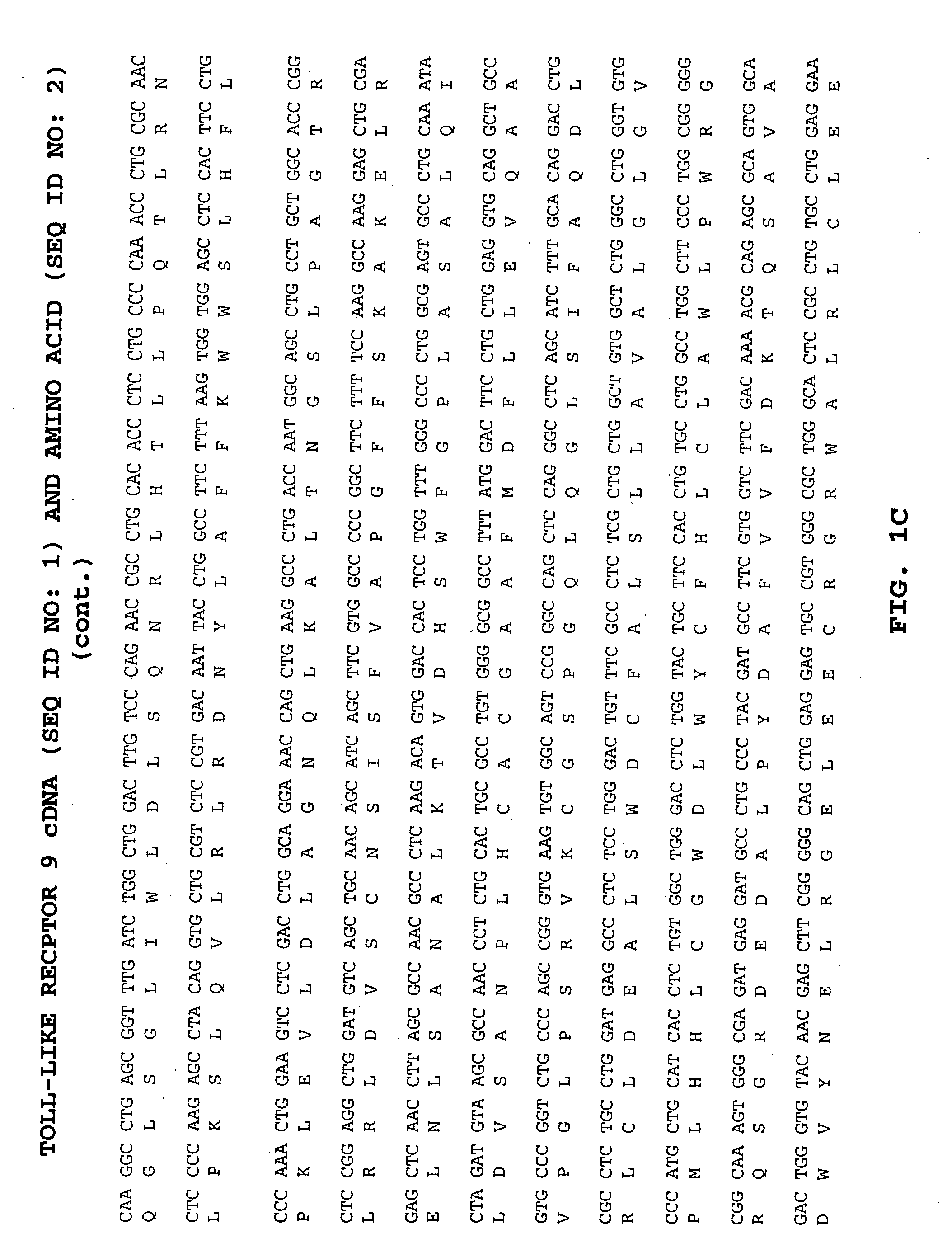Methods of therapy and diagnosis using targeting of cells that express toll-like receptor proteins
a technology of toll-like receptors and targeting of cells, which is applied in the direction of antibody medical ingredients, peptide/protein ingredients, drug compositions, etc., can solve the problems of reducing the ability of cells to present antigens and impeding the immune response against tumor-specific antigens, so as to enhance the effect of therapeutic agents
- Summary
- Abstract
- Description
- Claims
- Application Information
AI Technical Summary
Benefits of technology
Problems solved by technology
Method used
Image
Examples
example 1
Cell Lines of Lymphoma and Leukemia Origin Express High Levels of TLR9 mRNA
[0143] Expression of TLR9 was determined in various lymphoid and myeloid cell lines. Poly-A messenger RNA was isolated from the cell lines listed in Table 1 and subjected to quantitative, real-time PCR analysis (Simpson, et al., Molec. Vision. 6: 178-183 (2000)) to determine the relative copy number of TLR9 mRNA expressed per cell in each line. Elongation factor 1 mRNA expression was used as a positive control and normalization factors in all samples.
[0144] All assays were performed in duplicate with the resulting values averaged and expressed as “−” for samples with no detectable TLR 9 mRNA in that sample to “+++” for samples with the highest mRNA copy number for TLR9. The following quantitation scale for the real-time PCR experiments was used: “−”=0 copies / cell; “+”=approximately 1-10 copies / cell; “++”=approximately 11-50 copies / cell; and “+++”=approximately >50 copies / cell. The results are indicated in T...
example 2
TLR9 mRNA is Highly Expressed in Patient Tissues
[0146] Expression of TLR9 was determined in various healthy and tumor tissues (Table 2). Poly-A mRNA was isolated from the tonsilar lymph node and lymphoma, AML and Hodgkin's Disease tissue samples obtained from the Cooperative Human Tissue Network (CHTN, National Cancer Institute). All other RNAs were purchased from Clontech (Palo Alto, Calif.) and Ambion (Austin, Tex.). Tonsilar lymph nodes were used as non-lymphoma containing nodal tissue (7117), whereas 5348, 5856 and 6796 were B-cell follicular lymphomas and samples 22601 and 6879 were diffuse large B-cell lymphoma samples. Lymph node and lymphoma patient tissue samples were snap frozen immediately after surgical removal. Poly-A+ mRNA was subjected to quantitative, real-time PCR analysis, as described in Example 1, to determine the relative expression of TLR9 mRNA in the sample. All assays were performed in duplicate with the resulting values averaged and expressed as “−” for sam...
example 3
Diagnostic Methods Using TLR9-Specific antibodies to Detect TLR9 Expression
[0148] Expression of TLR9 in tissue samples (normal or diseased) was detected using anti-TLR9 antibodies (see Table 3). Samples were prepared for immunohistochemical (IHC) analysis by fixing tissues in 10% formalin embedding in paraffin, and sectioning using standard techniques. Sections were stained using the TLR9-specific antibody followed by incubation with a secondary horse radish peroxidase (HRP)-conjugated antibody and visualized by the product of the HRP enzymatic reaction. Data as seen in Table 3 shows that TLR9 is highly expressed on cell surface of tumor tissues. No expression of TLR9 was observed on the cell surface of normal tissues. In addition to cell surface expression of TLR9 on leukemia and lymphoma tissues, TLR9 expression was found in solid tumors of prostate, breast, colon, and squamous cell carcinoma (see Table 4). Based on this expression pattern, it is likely that other cancers of epit...
PUM
| Property | Measurement | Unit |
|---|---|---|
| Dimensionless property | aaaaa | aaaaa |
| Therapeutic | aaaaa | aaaaa |
| Body weight | aaaaa | aaaaa |
Abstract
Description
Claims
Application Information
 Login to View More
Login to View More - R&D
- Intellectual Property
- Life Sciences
- Materials
- Tech Scout
- Unparalleled Data Quality
- Higher Quality Content
- 60% Fewer Hallucinations
Browse by: Latest US Patents, China's latest patents, Technical Efficacy Thesaurus, Application Domain, Technology Topic, Popular Technical Reports.
© 2025 PatSnap. All rights reserved.Legal|Privacy policy|Modern Slavery Act Transparency Statement|Sitemap|About US| Contact US: help@patsnap.com



